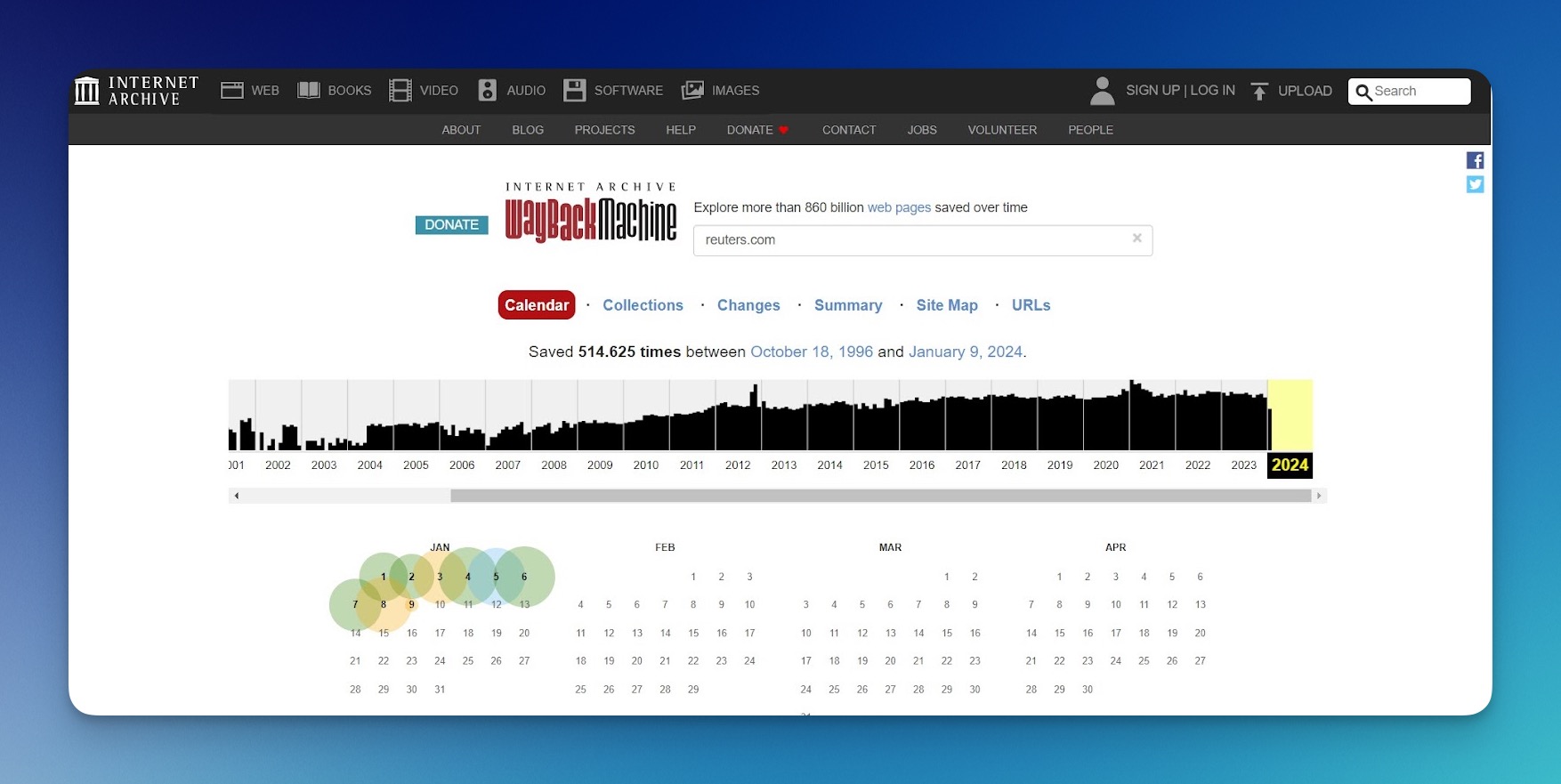
Figuring out how to check when a website was last updated can give you a leg up in the online landscape. It allows you to understand your competitors better, keep track of your own website’s update schedule, or simply ensure you are consuming the most relevant and recent information.
Now, let’s explore different methods to see the last modified date of a web page.
7 Ways to Check When a Website Was Last Updated
Each method has its own advantages and complexities, and we'll guide you through all of them, step by step.
1. Using HTTP Header Checker to Check the Last Modification Date
HTTP headers contain useful information about server requests and responses. Among these data, you can find the 'last-modified' header, which indicates the date and time the web page was last altered.
Here's how to uncover it:
- Visit SEOmator’s Free HTTP Header & Status Code Checker.
- Type or paste the URL of the webpage you want to inspect, and click ‘Submit’.
- The tool will show you various information including the date.

2. Checking Source Code to See Last Updated Date
The source code is like the blueprint of a website. It's sometimes a treasure trove of information - including the date of the website's last update. However, not all websites display this data in their source code, so it might not always work but is certainly worth trying.
Here's how to view the source code:
- Go to the web page you want to check.
- Right-click anywhere on the page, and select 'View Page Source' or 'Inspect Element'.
- Press Ctrl+F (Command+F on Mac) to bring up the search box and type in 'Last Modified'.
- Look for a line that says something like <meta name="Last-Modified" content="2021-04-22T07:30:04Z" />. The date and time in the content section is what you're looking for.

03. Checking Sitemap to See Last Update Date
A sitemap is essentially a roadmap of a website, often used by search engines to crawl and index a site more effectively. Sitemaps also usually contain the last modified dates for each page. It's a bit more technical than previous methods but potent once mastered!
Here's how:
- Type or paste the sitemap URL into your browser's address bar and press enter. If you don’t know the sitemap of a website, you can find it by using SEOmator’s free sitemap finder tool.
- Look through the XML file for ‘lastmod’ tags. The dates listed next to these tags represent the last time each webpage was updated.

4. Using Google Search to Check Last Modification Date
Google, our good old friend, can also give snippets of this information. This method relies on Google's indexing and doesn't work with websites Google hasn't crawled.
Here's the process:
- In the Google search bar, type "site:www.example.com" (replace 'example.com' with the actual URL).
- Look at the snippets under each search result. Sometimes, you'll find a date there - that's Google's best guess as to when a page was last updated.

5. Checking Command URL to See Last Update Date
Certain websites permit access to their web server information, especially Apache servers. Entering a specific URL can reveal the 'Last Modified' dates.
Follow these steps:
- Add /?=PHPE9568F36-D428-11d2-A769-00AA001ACF42 after your URL.
- If the website is Apache, a page will appear displaying the 'Last Modified' date.
6. Checking Google Cache to See Last Update Date
Google’s cache provides a kind of 'snapshot' of a webpage at the time it was last visited by Googlebot.
Here's how to use it:
- Go to Google's cached page. To do this, enter http://webcache.googleusercontent.com/search?q=cache:http://example.com/ in the search bar but change ‘http://example.com/’ to any URL you want to visit.
- Look at the top of the page, where you'll see a note like 'This is Google's cache of www.example.com. It is a snapshot of the page as it appeared on [date].'

7. Checking Internet Archive to See Last Update Date
The Internet Archive's Wayback Machine takes 'snapshots' of web pages over time, allowing you to see when a page was updated.
Follow these steps:
- Go to The Wayback Machine.
- Enter the website's URL.
- Peruse the timeline of 'snapshots'—these dates indicate when the site was updated.

Why Is It Important to Keep Up-to-date a Website?
Modern internet users can tell in an instant whether a website is current or if it’s suffering from neglect. Frequent website updates are crucial in maintaining your site's relevancy, trust, and ranking.
So, not only should you know how to find the last modified date of a web page, you should also be committed to updating your own website regularly.

But what makes routine updates so important?
⭐ Relevancy and User Experience
Updating your website ensures that your content remains relevant to your users. Trends change, information evolves, and technology advances. If your website content is outdated, users may find your site unhelpful. This could potentially lead to higher bounce rates and lower engagement, thus impacting your overall web performance.
Imagine yourself in the shoes of a visitor to your website. A site with fresh, current information not only provides a great user experience but also creates a good impression. It tells your visitors that you care about their needs and stay updated with industry trends.
To improve the relevancy of your website:
- Keep your blog posts and articles up-to-date. Pay attention to posts that receive a high amount of traffic and ensure that they contain the most recent information.
- Review and update your product or services pages frequently to reflect your current offerings.
- Regularly check and update your contact information, FAQs, and other details.
- Update the visuals, such as photos, videos, and other graphic content, occasionally to keep the look of your site fresh and engaging.
⭐ SEO Advantage
Search engine optimization (SEO) strategies are dynamic, pivoting on the continually changing algorithms of search engines. Regular content updates signal to search engines that your site is alive and kicking, which could give your site an SEO ranking boost.
When you frequently update your website, Google, Bing, and other search engines will index your site more often. New content could potentially be a ticket to better rankings since Google algorithms are partial to fresh and relevant content.
Here are some ways to keep your site SEO-friendly:
- Freshen up your keywords by reexamining them periodically to ensure they align with the latest SEO trends.
- Introduce new content that is helpful and informative for your audience. Regular blog posts or resources can be useful for this.
- Consider occasionally reshuffling and reformatting existing content. Even subtle changes like adding new images, headlines, or reformulating content in a different context, can help.
- The comment section is also valuable. User-generated content, such as comments or reviews, could get the new content ball rolling. Encourage interactions, and make sure to respond.
- Clean up old, outdated content. Any articles or information that might be outdated or irrelevant should be removed or updated.
🔎You may want to read: Content Optimization: The Complete Guide to Boost Rankings
⭐ Trustworthiness and Credibility
Just like any physical store, clutters, cobwebs, and stale stocks don't make for a welcoming or trustworthy environment. Similarly, a modern, regularly updated website appears professional and reliable. It shows that you value your business and your customers and are engaged in your industry.
Ensure that every detail on your site, from the copyright year in your site’s footer to the latest team member's photo in the 'About Us' page, is current.
Well-maintained sites reduce customer churn and encourage repeat visits.
Issues About Checking the Last Updated Date of a Website
While we have a range of methods to determine when a website was last updated, it's also important to keep the potential criticisms and controversies in mind.
These issues don't necessarily undermine the process of finding out the last known modified date, but they're useful to consider to place this digital sleuthing work in a broader context.

Here's what you need to know:
🚩Lack of Universality in Perception of Updates
Not all changes made on a website necessarily indicate a real update.
For example, a minor graphic modification or a slight alteration in website theme may not qualify as a significant update for some, while others may consider it part of website refreshing.
- Text content vs. non-text content: The changes in non-text content like images, videos, PDF files, etc., often aren't reflected as updates by search engines. So, there's a possibility that a website may have undergone extensive changes in its non-text content but still appears 'unchanged' due to lack of revised text content.
- Visible changes vs. non-visible changes: Often, behind-the-scenes updates like improvement in HTML coding, changes in meta description, or modification of technical SEO elements are overlooked.
🚩Dependence on the Site Owner
It's often up to the website owner whether to display the last updated date or not. Some websites may be manipulated by site owners to appear as 'recently updated' when they're not, just to seem more current and reliable.
In contrast, some site owners remove or hide the last updated date of 'evergreen content' (content whose relevance doesn't depend on freshness) to avoid it looking outdated, even if it's not. This creates ambiguity in determining the authenticity of the perceived update.
🚩Different Sources, Different Results
Often, using different methods to check when a website was last updated may yield varying results due to the differences in indexing methods and frequency. For instance, the 'last-modified' date seen in the source code may differ from the date found in Google's cache.
Which one then should you consider? Here's where controversies arise. Some argue that the HTTP header check or source code check gives the most accurate results, while others claim the .XML Sitemap or Google Search methods are more reliable.
🚩Privacy Concerns
While some people may find the ability to check a website's update history useful, others see it as a breach of privacy. The notion of digging into backend elements to find out when a web page was last modified strikes some as intrusive.
Is it fair to keep such a close eye on what is, ultimately, someone else's 'property'? The debate rages on.
🚩The Google Paradox
Interestingly, Google is one of the primary tools individuals use to check when a site was last updated, but the tech giant has been known to be the least transparent about its updates.
When and how Google updates its own search algorithms is a hot topic of debate, leading to the irony of using Google to check for others' updates while Google keeps its own under wraps.
Conclusion
There are several ways to figure out when a web page was last modified. As with any method, it's important not merely to know how to use each method or tool, but to understand each one's limitations.
Checking when a website was last updated is not a flawless process and can sometimes stir up controversies, but it nevertheless remains an invaluable practice for marketers, SEO experts, and curious netizens alike.
To sum it up, a regularly updated website can boost its search engine rankings. Learning when a website was last updated lets you gauge its SEO efforts and identify competitors who take their search engine optimization seriously.
Update your knowledge, just as you would your website, and make your digital journey an enlightening one!
🔎You may also want to read:
- What Should Be the First Step of a Structured SEO Plan?





